|
|
|
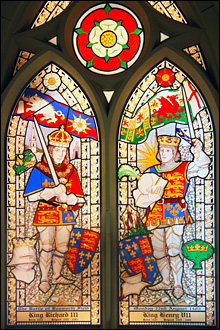

THE BATTLE OF BOSWORTH FIELD (Aug. 22, 1485), was fought between Richard III and Henry, Earl of Richmond, afterwards Henry VII.
On August [7], Henry landed at Milford Haven and passed on without opposition to Shrewsbury, being joined by a large number of Welshmen. He then marched on to Tamworth, where he arrived on the 18th.
On the 20th he was at Atherstone, where he was met by Lord Stanley and by Sir William Stanley, who both promised to desert Richard during
the battle. Meanwhile Richard, having mustered his forces at Nottingham, marched to Leicester and encamped at Bosworth on the 21st.
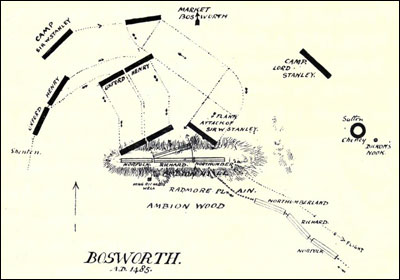
On the next morning the two armies met between Bosworth and Atherstone at a place known as Whitemoors, near the village of Sutton Cheneys. The battle was mainly a hand-to-hand encounter, the Stanleys
for some time keeping aloof from the fight till, at a critical moment, they joined Richmond. Richard, perceiving that he was betrayed, and crying out, "Treason, treason!" endeavoured only to sell his
life as dearly as possible, and refused to leave the field till, overpowered by numbers, he fell dead in the midst of his enemies. The crown was picked up on the field of battle and placed by Sir William
Stanley on the head of Richmond, who was at once saluted king by the whole army.
Among those that perished on Richard's side were the Duke of Norfolk, Lord Ferrers, Sir Richard Ratcliffe, and Sir Robert Brackenbury,
while the only person of note in Henry's army who was slain was his standard-bearer, Sir William Brandon, who is said to have been killed by Richard himself.
The Dictionary of English History. Sidney J. Low and F. S. Pulling, eds.
London: Cassell and Company, Ltd., 1910. 198.
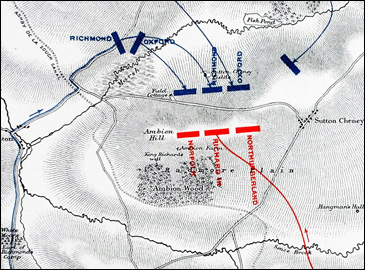
THE BATTLE OF BOSWORTH
By C. Oman
At last on August 1 Henry of Richmond set sail from Harfleur; the Regent Anne of France had lent him 60,000 francs, and collected for him 1,800 mercenaries
and a small fleet. The adventurer was accompanied by his uncle, Jasper Tudor, the Earl of Oxford, Sir Edward Woodville, Sir John Welles,
heir of the attainted barony of Welles, Sir Edward Courtenay, who claimed the earldom of Devon, his kinsman the Bishop of Exeter [Peter Courtenay], Morton, Bishop of Ely,
and some scores of exiled knights and squires, among whom Yorkists were almost as numerous as Lancastrians. The French auxiliaries were under a Savoyard captain named Philibert de Chaundé.
The Marquis of Dorset and Sir John Bourchier had been left at Paris in pledge for the loan made by the French government. Richmond did not desire to have the marquis
with him, for he had been detected in correspondence with his mother the queen-dowager, who urged him to abandon conspiracy and submit to King Richard.
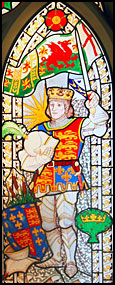 Stealing down the Breton coast, so as to avoid the English fleet, Richmond turned northward when he had passed the longitude of Lands End, and came ashore in Milford Haven on August 7. He had selected
this remote region as his landing point both because he knew that he was expected to strike at the English south coast, and because he had assurance of help from many old retainers of his uncle the
Earl of Pembroke. He was himself a Welshman and could make a good appeal to the local patriotism of his countrymen. On landing he raised not only the royal banner of
England but the ancient standard of Cadwallader, a red dragon upon a field of white and green, the beast which was afterwards used as the device of the house of Tudor, and the sinister supporter
of their coat-of-arms.
Stealing down the Breton coast, so as to avoid the English fleet, Richmond turned northward when he had passed the longitude of Lands End, and came ashore in Milford Haven on August 7. He had selected
this remote region as his landing point both because he knew that he was expected to strike at the English south coast, and because he had assurance of help from many old retainers of his uncle the
Earl of Pembroke. He was himself a Welshman and could make a good appeal to the local patriotism of his countrymen. On landing he raised not only the royal banner of
England but the ancient standard of Cadwallader, a red dragon upon a field of white and green, the beast which was afterwards used as the device of the house of Tudor, and the sinister supporter
of their coat-of-arms.
For a few days Henry received but trifling reinforcements, but he struck into the Cardiganshire mountains, a district where, if his adherents were slow to join him, he might hope to maintain an irregular
warfare in the style of Owen Glendower. After a short delay the Welsh gentry began to come in to his aid; the wealthiest and most warlike chief Rhys ap Thomas consented to put
himself at their head, after he had been promised the justiciarship of South Wales. Sir Walter Herbert had charge of the district in King Richard's name, but the levies that he called out melted away to
the invader's camp, and he himself was suspected of half-heartedness.
Richmond met no resistance as he conducted his ever-growing host across Cardiganshire toward the upper Severn. By way of Newtown and Welshpool he came down on Shrewsbury, which opened its gates on
August 15 after one day's parleying; this was a good omen, for hitherto the earl had received no help save from the Welsh. On the next day but one Sir Gilbert Talbot, uncle and guardian of the
young Earl of Shrewsbury, joined him with 500 of the retainers of his old Lancastrian house.
From this moment onward English malcontents with small bodies of recruits kept pouring into Richmond's camp, but though he advanced boldly into the midlands, making directly towards Richard's post at
Nottingham, his whole force was still small; he had not more than 5,000 men at the decisive battle that gave him the crown. His confidence was due to the fact that he had secret promises of aid from
all sides; the Stanleys had let him pass Shrewsbury unmolested, and had sent him word that they would place the forces of Cheshire and Lancashire at his disposition when they had got Lord Strange
[son of Thomas, Lord Stanley] out of the king's hands. Many other magnates had already given similar assurances.
Meanwhile Richard had received the news of the invader's landing somewhat later than he had expected, owing to the remoteness of Milford Haven. When he learnt that Richmond
was marching straight towards him, he ordered out all the shire levies which had been so long ready, and summoned in his most trustworthy adherents in the baronage. Norfolk,
Northumberland, and some twenty more of the peers rallied to his standard at Leicester within a few days,1 but the lords of the extreme south and west were still
absent when the crisis came.
Lord Stanley, who had been summoned with the rest, sent a futile excuse, yet raised all Cheshire and Lancashire under his own banner and advanced as far as Lichfield. His son
Strange made an attempt to escape from custody and join him, whereupon Richard put him in irons, and sent word to his father that if he turned traitor his son should be beheaded without a moment's delay.
This did not prevent Sir William Stanley, who commanded a part of the Cheshire levies, from visiting Richmond's camp at Stafford, and pledging himself to join him on the
battlefield; but the head of the house hung back as long as possible, to save the life of his heir.
On August 20 the earl's army advanced from Tamworth to Atherstone, while the king had gathered his forces at Leicester. On the 21st the one moved forward from Atherstone to the White Moor, a few miles
south-west from Bosworth, while the other marched out from Leicester to Sutton Cheney; only two miles divided their camps, and it was obvious that a decisive engagement must take place next day. The host
of the Stanleys, with Sir William leading its vaward, and Lord Stanley keeping discreetly to the rear, was near Bosworth that same evening,
equidistant from the two hostile armies. Both the king and Richmond were aware of its approach, and neither was pleased, for Richard apprehended treason, and his rival had hoped to be openly joined by
these cautious allies before the battle began.
The king was well aware that the spirit of his troops was unsatisfactory; his confidential advisers had warned him that treachery was on foot; and unless he could bear down the enemy by his first onset,
his superior numbers—he had two men to Richmond's one—were not likely to avail him much. But he trusted to his own energy and military skill, and hoped to conquer despite the lukewarmness of
the majority of his followers. Nevertheless he had dismal forebodings; his rest was broken by horrible dreams, and he showed next morning a face not only haggard, but disfigured with a death-like pallor.2
But his courage was unbroken, and he promised victory to his doubting captains in words of haughty confidence. His position was excellent; the army was drawn out in the usual three divisions on the slopes
of Ambion Hill, a well-marked rising ground two miles south of Bosworth. It was partly divided from the enemy by marshy fields formed by the little river Sence. The king led the main battle, the
Duke of Norfolk the vaward or right wing, the Earl of Northumberland the rear.
His adversaries, on the other side of the marsh, had formed their smaller host in two divisions only; the Earl of Oxford led the vaward, while the main battle was under Richmond's
own command. Contrary to what might have been expected, they took the offensive, reckoning, no doubt, on treachery in the king's ranks. They moved off eastward, Oxford's corps leading, till they had circumvented
the marshy ground, and faced the royalists with the sun at their backs and the wind also behind them—advantages of no mean importance in the archery-fight which always opened an English engagement.
When they had cleared the boggy tract, and began to advance up the slopes of Ambion Hill, with their western flank still covered by the impassable marsh, the king first opened upon them with his artillery,
and then charged down upon them. Norfolk's corps came into collision with that of Oxford, while Richard attacked the earl's
main body. Northumberland, on the other wing of the royal host, deliberately held back and would not get into action. Before ordering the line to advance, the king had sent orders
to Lord Stanley to draw in to his banner, and, when he made no movement issued a command for the instant execution of his son Strange. But those charged with the matter wisely deferred
obedience till the battle should be over, and the young man escaped with his life.
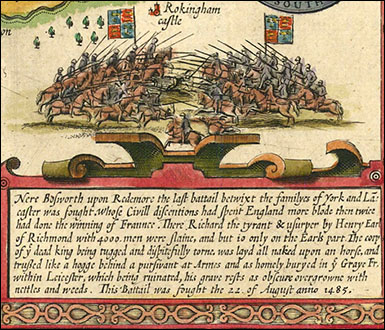
When the two armies came into close contact it was at once evident that many of the king's men were not inclined to fight. They hung back, kept up a feeble archery fire from a distance, and refused to close.
Oxford, who had halted to receive the attack, bade his banner go forward again, and began to mount the slopes. On this more serious fighting began, for Norfolk
with his son Surrey, and some others of the king's adherents, tried to do their duty, and fell hotly upon the earl's front.
At the same moment Richard himself, having marked the position of Richmond in the hostile line, charged at the head of his bodyguard, broke into the Lancastrian
main body and seemed for a moment likely to prevail. He slew with his own hand, as it is said, Sir William Brandon, Richmond's standard-bearer, and encountered the earl hand to hand for a short space. But by this
moment the battle was lost, for Sir William Stanley, who had been drawing nearer ever since the fighting began, now fell upon Richard's host in flank and rear. With a cry of treason
the royalist main body broke up and fled. The Stanleys took up the pursuit, which passed away to the east with no great slaughter, for the pursuers understood that the vanquished had no heart in the struggle and had
deliberately given them the victory.
King Richard, however, refused to fly, though faithful friends brought him his horse, and bade him escape while they held back the enemy for a moment. The usurper replied that at least
he would die King of England, and plunged back into the fight. A moment later, shouting "Treason! treason!" as he laid about him with his battle-axe, he was ringed round by many foes and hewn down; his helmet was
battered through and his brains beaten out.
It was the end of a brave man, and his courage touched the heart even of those who remembered his crimes. The finest stanzas written in fifteenth century England were given to his memory by an admiring enemy, a
retainer of the Stanleys, who wrote the Ballad of Lady Bessie:—
Then a knight to King Richard gan say—good Sir William Harrington—
He saith "all wee are like this day to the death soone to be done;
There may no man their strokes abide, the Stanleys' dints they be so stronge.
Yee may come back at another tide, methinks yee tarry here too longe.
Your horsse at your hand is ready, another day you may worshipp win
And come to raigne with royaltye, and weare your crown and be our king".
"Nay, give me my battle-axe in my hand, sett the crowne of England on my head so high,
For by Him that made both sea and land, King of England this day I will dye.
One foot I will never flee whilst the breath is my brest within."
As he said so did it be—if hee lost his life he died a king.3
|
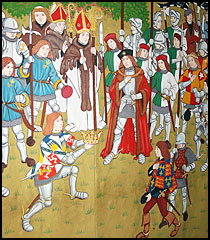 The battered crown which had fallen from Richard's helmet was found in a hawthorn bush, where it had probably been hidden by a plunderer, and set on the head of Richmond by
Lord Stanley, while all the victorious army hailed the earl by his new title of Henry VII.
The battered crown which had fallen from Richard's helmet was found in a hawthorn bush, where it had probably been hidden by a plunderer, and set on the head of Richmond by
Lord Stanley, while all the victorious army hailed the earl by his new title of Henry VII.
Along with the king there fell his chief supporter, John Duke of Norfolk; the Lord Ferrers of Chartley, Sir Richard Ratcliffe, his well-known councillor,
Sir Robert Brakenbury, lieutenant of the Tower of London, Sir Robert Percy, controller of the royal household, Sir William Conyers, and about 1,000 others, as was reported, probably with some exaggeration, for the
battle had not been hot nor the pursuit merciless.
The victors lost not above 100 men, of whom the only personage of note was the standard-bearer Sir William Brandon. The Earl of Surrey was taken prisoner, grievously wounded, and lodged
in prison. Catesby was captured in the flight, and executed along with two yeomen of the king's chamber—a father and son named Breacher. These were the only lives taken in cold blood by
Henry of Richmond.
The corpse of Richard was stripped and carried to Leicester across the back of a horse in unseemly fashion, with head and arms hanging down. It was exposed to the public view for two days, and then decently buried
in the church of the Greyfriars. His monument was destroyed and his bones scattered at the dissolution of the monasteries.
1. If the Ballad of Bosworth Feilde can be trusted, there were with the king the following peers: Norfolk, Kent, Surrey, Lincoln, Northumberland, Westmorland [Ralph Neville, 3rd Earl], Zouch [John la Zouche, 7th Baron], Maltravers [Thomas Fitzalan, 7th Baron], Arundel, Grey of Codnor [Henry Grey, 7th Baron], Audley [James Touchet, 6th Baron], Berkeley [William, 1st Viscount Berkeley], Ferrers of Chartley [Walter Devereux, 7th Baron] and Ferrers of Groby [John Bourchier, 6th Baron], Fitzhugh [Richard, 6th Baron], Dacre [Thomas, 2nd Baron Dacre of Gillesland], Scrope of Bolton [John, 5th Baron], Scrope of Upsal [Ralph, 9th Baron], Lumley [George, 3rd Baron], and Greystock [Ralph de Greystoke, 5th Baron Greystoke]. Lovel seems to have been still with the fleet in the Channel. The list cannot be trusted for all the names.
2. Continuator of the Croyland Chronicle, Fulman, 1684, p. 374.
3. I have corrected some obvious verbal errors in Lady Bessie mainly from the parallel passage—nearly the same in wording—in Bosworth Feilde. See Percy Folio MS., iii., 257 and 362.
Oman, C. The History of England.
London: Longmans, Green, and Co., 1906. 491-6.
Other Local Resources:
Books for further study:
Bennett, Michael. The Battle of Bosworth.
Stroud, Gloucestershire: Sutton Publishing, 2000.
Chrimes, S. B. Henry VII.
New Haven, CT: Yale University Press, 1999.
Gravett, Christopher. Bosworth 1485: Last Charge of the Plantagenets.
Oxford: Osprey Publishing, 1999.
Hallam, E., ed. Wars of the Roses: From Richard II to the Fall of Richard III
at Bosworth Field—Seen Through the Eyes of Their Contemporaries.
Grove Press, 1988.
Hammond, Peter. Richard III and the Bosworth Campaign.
Barnsley, Yorkshire: Pen and Sword, 2011.
Hicks, Michael. The Wars of the Roses 1455-1485.
New York: Routledge, 2003.
Ingram, Mike. Battle Story: Bosworth, 1485.
The History Press, 2012.
Ingram, Mike. Richard III and the Battle of Bosworth.
Helion and Company, 2019.
Jones, Michael. Bosworth 1485.
Pegasus Books, 2016.
More, Sir Thomas. History of King Richard III.
Hesperus Press, 2005.
Ross, Charles. Richard III.
New Haven, CT: Yale University Press, 2011.
Rowse, A. L. Bosworth Field & the Wars of the Roses.
Wordsworth Military Library; New Ed., 1999.
Shakespeare, William. Richard III.
Folger Shakespeare Library, 2004.
Weir, Alison. The Wars of the Roses.
New York: Ballantine Books, 1996.
The Battle of Bosworth Field on the Web:
 | to Richard III |
 | to Henry VII |
 | to Wars of the Roses
|
 | to Luminarium Encyclopedia |
Site ©1996-2022 Anniina Jokinen. All rights reserved.
This page was created on April 12, 2007. Last updated August 22, 2022.
|
Index of Encyclopedia Entries:
Medieval Cosmology
Prices of Items in Medieval England
Edward II
Isabella of France, Queen of England
Piers Gaveston
Thomas of Brotherton, E. of Norfolk
Edmund of Woodstock, E. of Kent
Thomas, Earl of Lancaster
Henry of Lancaster, Earl of Lancaster
Henry of Grosmont, Duke of Lancaster
Roger Mortimer, Earl of March
Hugh le Despenser the Younger
Bartholomew, Lord Burghersh, elder
Hundred Years' War (1337-1453)
Edward III
Philippa of Hainault, Queen of England
Edward, Black Prince of Wales
John of Eltham, Earl of Cornwall
The Battle of Crécy, 1346
The Siege of Calais, 1346-7
The Battle of Poitiers, 1356
Lionel of Antwerp, Duke of Clarence
John of Gaunt, Duke of Lancaster
Edmund of Langley, Duke of York
Thomas of Woodstock, Gloucester
Richard of York, E. of Cambridge
Richard Fitzalan, 3. Earl of Arundel
Roger Mortimer, 2nd Earl of March
The Good Parliament, 1376
Richard II
The Peasants' Revolt, 1381
Lords Appellant, 1388
Richard Fitzalan, 4. Earl of Arundel
Archbishop Thomas Arundel
Thomas de Beauchamp, E. Warwick
Robert de Vere, Earl of Oxford
Ralph Neville, E. of Westmorland
Thomas Mowbray, Duke of Norfolk
Edmund Mortimer, 3. Earl of March
Roger Mortimer, 4. Earl of March
John Holland, Duke of Exeter
Michael de la Pole, E. Suffolk
Hugh de Stafford, 2. E. Stafford
Henry IV
Edward, Duke of York
Edmund Mortimer, 5. Earl of March
Henry Percy, Earl of Northumberland
Sir Henry Percy, "Harry Hotspur"
Thomas Percy, Earl of Worcester
Owen Glendower
The Battle of Shrewsbury, 1403
Archbishop Richard Scrope
Thomas Mowbray, 3. E. Nottingham
John Mowbray, 2. Duke of Norfolk
Thomas Fitzalan, 5. Earl of Arundel
Henry V
Thomas, Duke of Clarence
John, Duke of Bedford
Humphrey, Duke of Gloucester
John Talbot, Earl of Shrewsbury
Richard, Earl of Cambridge
Henry, Baron Scrope of Masham
William de la Pole, Duke of Suffolk
Thomas Montacute, E. Salisbury
Richard Beauchamp, E. of Warwick
Henry Beauchamp, Duke of Warwick
Thomas Beaufort, Duke of Exeter
Cardinal Henry Beaufort
John Beaufort, Earl of Somerset
Sir John Fastolf
John Holland, 2. Duke of Exeter
Archbishop John Stafford
Archbishop John Kemp
Catherine of Valois
Owen Tudor
John Fitzalan, 7. Earl of Arundel
John, Lord Tiptoft
Charles VII, King of France
Joan of Arc
Louis XI, King of France
Charles the Bold, Duke of Burgundy
The Battle of Agincourt, 1415
The Battle of Castillon, 1453
The Wars of the Roses 1455-1485
Causes of the Wars of the Roses
The House of Lancaster
The House of York
The House of Beaufort
The House of Neville
The First Battle of St. Albans, 1455
The Battle of Blore Heath, 1459
The Rout of Ludford, 1459
The Battle of Northampton, 1460
The Battle of Wakefield, 1460
The Battle of Mortimer's Cross, 1461
The 2nd Battle of St. Albans, 1461
The Battle of Towton, 1461
The Battle of Hedgeley Moor, 1464
The Battle of Hexham, 1464
The Battle of Edgecote, 1469
The Battle of Losecoat Field, 1470
The Battle of Barnet, 1471
The Battle of Tewkesbury, 1471
The Treaty of Pecquigny, 1475
The Battle of Bosworth Field, 1485
The Battle of Stoke Field, 1487
Henry VI
Margaret of Anjou
Richard Plantagenet, Duke of York
Edward IV
Elizabeth Woodville
Richard Woodville, 1. Earl Rivers
Anthony Woodville, 2. Earl Rivers
Jane Shore
Edward V
Richard III
George, Duke of Clarence
Ralph Neville, 2. Earl of Westmorland
Richard Neville, Earl of Salisbury
Richard Neville, Earl of Warwick
Edward Neville, Baron Bergavenny
William Neville, Lord Fauconberg
Robert Neville, Bishop of Salisbury
John Neville, Marquis of Montagu
George Neville, Archbishop of York
John Beaufort, 1. Duke Somerset
Edmund Beaufort, 2. Duke Somerset
Henry Beaufort, 3. Duke of Somerset
Edmund Beaufort, 4. Duke Somerset
Margaret Beaufort
Edmund Tudor, Earl of Richmond
Jasper Tudor, Earl of Pembroke
Humphrey Stafford, D. Buckingham
Henry Stafford, Duke of Buckingham
Humphrey Stafford, E. of Devon
Thomas, Lord Stanley, Earl of Derby
Sir William Stanley
Archbishop Thomas Bourchier
Henry Bourchier, Earl of Essex
John Mowbray, 3. Duke of Norfolk
John Mowbray, 4. Duke of Norfolk
John Howard, Duke of Norfolk
Henry Percy, 2. E. Northumberland
Henry Percy, 3. E. Northumberland
Henry Percy, 4. E. Northumberland
William, Lord Hastings
Henry Holland, Duke of Exeter
William Fitzalan, Earl of Arundel
William Herbert, 1. Earl of Pembroke
John de Vere, 12th Earl of Oxford
John de Vere, 13th Earl of Oxford
Thomas de Clifford, 8. Baron Clifford
John de Clifford, 9. Baron Clifford
John Tiptoft, Earl of Worcester
Thomas Grey, 1. Marquis Dorset
Sir Andrew Trollop
Archbishop John Morton
Edward Plantagenet, E. of Warwick
John Talbot, 2. E. Shrewsbury
John Talbot, 3. E. Shrewsbury
John de la Pole, 2. Duke of Suffolk
John de la Pole, E. of Lincoln
Edmund de la Pole, E. of Suffolk
Richard de la Pole
John Sutton, Baron Dudley
James Butler, 5. Earl of Ormonde
Sir James Tyrell
Edmund Grey, first Earl of Kent
George Grey, 2nd Earl of Kent
John, 5th Baron Scrope of Bolton
James Touchet, 7th Baron Audley
Walter Blount, Lord Mountjoy
Robert Hungerford, Lord Moleyns
Thomas, Lord Scales
John, Lord Lovel and Holand
Francis Lovell, Viscount Lovell
Sir Richard Ratcliffe
William Catesby
Ralph, 4th Lord Cromwell
Jack Cade's Rebellion, 1450
Tudor Period
King Henry VII
Queen Elizabeth of York
Arthur, Prince of Wales
Lambert Simnel
Perkin Warbeck
The Battle of Blackheath, 1497
King Ferdinand II of Aragon
Queen Isabella of Castile
Maximilian I, Holy Roman Emperor
King Henry VIII
Queen Catherine of Aragon
Queen Anne Boleyn
Queen Jane Seymour
Queen Anne of Cleves
Queen Catherine Howard
Queen Katherine Parr
King Edward VI
Queen Mary I
Queen Elizabeth I
Henry Fitzroy, Duke of Richmond
Margaret Tudor, Queen of Scotland
James IV, King of Scotland
The Battle of Flodden Field, 1513
James V, King of Scotland
Mary of Guise, Queen of Scotland
Mary Tudor, Queen of France
Louis XII, King of France
Francis I, King of France
The Battle of the Spurs, 1513
Field of the Cloth of Gold, 1520
Charles V, Holy Roman Emperor
Eustace Chapuys, Imperial Ambassador
The Siege of Boulogne, 1544
Cardinal Thomas Wolsey
Archbishop Thomas Cranmer
Thomas Cromwell, Earl of Essex
Thomas, Lord Audley
Thomas Wriothesley, E. Southampton
Sir Richard Rich
Edward Stafford, D. of Buckingham
Thomas Howard, 2nd Duke of Norfolk
Thomas Howard, 3rd Duke of Norfolk
John Dudley, Duke of Northumberland
Charles Brandon, Duke of Suffolk
Thomas Boleyn, Earl of Wiltshire
George Boleyn, Viscount Rochford
John Russell, Earl of Bedford
Thomas Grey, 2. Marquis of Dorset
Henry Grey, D. of Suffolk
Charles Somerset, Earl of Worcester
George Talbot, 4. E. Shrewsbury
Francis Talbot, 5. E. Shrewsbury
Henry Algernon Percy,
5th Earl of Northumberland
Henry Algernon Percy,
6th Earl of Northumberland
Ralph Neville, 4. E. Westmorland
Henry Neville, 5. E. Westmorland
William Paulet, Marquis of Winchester
Sir Francis Bryan
Sir Nicholas Carew
John de Vere, 15th Earl of Oxford
John de Vere, 16th Earl of Oxford
Thomas Seymour, Lord Admiral
Edward Seymour, Protector Somerset
Margaret Pole, Countess of Salisbury
Henry Pole, Lord Montague
Sir Geoffrey Pole
Thomas Manners, Earl of Rutland
Henry Manners, Earl of Rutland
Henry Bourchier, 2. Earl of Essex
Robert Radcliffe, 1. Earl of Sussex
Henry Radcliffe, 2. Earl of Sussex
George Hastings, Earl of Huntingdon
Henry Courtenay, Marquis of Exeter
George Neville, Baron Bergavenny
Sir Edward Neville
William, Lord Paget
William Sandys, Baron Sandys
William Fitzwilliam, E. Southampton
Sir Anthony Browne
Sir Thomas Wriothesley
Sir William Kingston
George Brooke, Lord Cobham
Sir Richard Southwell
Thomas Fiennes, 9th Lord Dacre
Sir Francis Weston
Henry Norris
Lady Jane Grey
Sir Thomas Arundel
Sir Richard Sackville
Sir William Petre
Sir John Cheke
Walter Haddon, L.L.D
Sir Peter Carew
Sir John Mason
Nicholas Wotton
John Taylor
Sir Thomas Wyatt, the Younger
Cardinal Lorenzo Campeggio
Cardinal Reginald Pole
Stephen Gardiner, Bishop of Winchester
Edmund Bonner, Bishop of London
Nicholas Ridley, Bishop of London
John Hooper, Bishop of Gloucester
John Aylmer, Bishop of London
Thomas Linacre
William Grocyn
Archbishop William Warham
Cuthbert Tunstall, Bishop of Durham
Richard Fox, Bishop of Winchester
Edward Fox, Bishop of Hereford
Pope Julius II
Pope Leo X
Pope Clement VII
Pope Paul III
Pope Pius V
Pico della Mirandola
Desiderius Erasmus
Martin Bucer
Richard Pace
Christopher Saint-German
Thomas Tallis
Elizabeth Barton, the Nun of Kent
Hans Holbein, the Younger
The Sweating Sickness
Dissolution of the Monasteries
Pilgrimage of Grace, 1536
Robert Aske
Anne Askew
Lord Thomas Darcy
Sir Robert Constable
Oath of Supremacy
The Act of Supremacy, 1534
The First Act of Succession, 1534
The Third Act of Succession, 1544
The Ten Articles, 1536
The Six Articles, 1539
The Second Statute of Repeal, 1555
The Act of Supremacy, 1559
Articles Touching Preachers, 1583
Queen Elizabeth I
William Cecil, Lord Burghley
Robert Cecil, 1st Earl of Salisbury
Sir Francis Walsingham
Sir Nicholas Bacon
Sir Thomas Bromley
Robert Dudley, Earl of Leicester
Ambrose Dudley, Earl of Warwick
Henry Carey, Lord Hunsdon
Sir Thomas Egerton, Viscount Brackley
Sir Francis Knollys
Katherine "Kat" Ashley
Lettice Knollys, Countess of Leicester
George Talbot, 6. E. of Shrewsbury
Elizabeth, Countess of Shrewsbury
Gilbert Talbot, 7. E. of Shrewsbury
Sir Henry Sidney
Sir Robert Sidney
Archbishop Matthew Parker
Walter Devereux, 1st Earl of Essex
Robert Devereux, 2nd Earl of Essex
Penelope Devereux, Lady Rich
Sir Christopher Hatton
Edward Courtenay, E. Devonshire
Edward Manners, 3rd Earl of Rutland
Thomas Radcliffe, 3. Earl of Sussex
Henry Radcliffe, 4. Earl of Sussex
Robert Radcliffe, 5. Earl of Sussex
William Parr, Marquis of Northampton
Henry Wriothesley, 2. Southampton
Henry Wriothesley, 3. Southampton
Charles Neville, 6. E. Westmorland
Thomas Percy, 7. E. Northumberland
Henry Percy, 8. E. Northumberland
Henry Percy, 9. E. Nothumberland
William Herbert, 1. Earl of Pembroke
Charles, Lord Howard of Effingham
Thomas Howard, 4th Duke of Norfolk
Henry Howard, 1. Earl of Northampton
Thomas Howard, 1. Earl of Suffolk
Henry Hastings, 3. E. of Huntingdon
Edward Manners, 3rd Earl of Rutland
Roger Manners, 5th Earl of Rutland
Francis Manners, 6th Earl of Rutland
Henry FitzAlan, 12. Earl of Arundel
Thomas, Earl Arundell of Wardour
Edward Somerset, E. of Worcester
William Davison
Sir Walter Mildmay
Sir Ralph Sadler
Sir Amyas Paulet
Gilbert Gifford
Anthony Browne, Viscount Montague
François, Duke of Alençon & Anjou
Mary, Queen of Scots
Henry Stuart, Lord Darnley
James Hepburn, Earl of Bothwell
Anthony Babington and the Babington Plot
John Knox
Philip II of Spain
The Spanish Armada, 1588
Sir Francis Drake
Sir John Hawkins
William Camden
Archbishop Whitgift
Martin Marprelate Controversy
John Penry (Martin Marprelate)
Richard Bancroft, Archbishop of Canterbury
John Dee, Alchemist
Philip Henslowe
Edward Alleyn
The Blackfriars Theatre
The Fortune Theatre
The Rose Theatre
The Swan Theatre
Children's Companies
The Admiral's Men
The Lord Chamberlain's Men
Citizen Comedy
The Isle of Dogs, 1597
Common Law
Court of Common Pleas
Court of King's Bench
Court of Star Chamber
Council of the North
Fleet Prison
Assize
Attainder
First Fruits & Tenths
Livery and Maintenance
Oyer and terminer
Praemunire
The Stuarts
King James I of England
Anne of Denmark
Henry, Prince of Wales
The Gunpowder Plot, 1605
George Villiers, 1st Duke of Buckingham
Robert Carr, Earl of Somerset
Arabella Stuart, Lady Lennox
William Alabaster
Bishop Hall
Bishop Thomas Morton
Archbishop William Laud
John Selden
Lucy Harington, Countess of Bedford
Henry Lawes
King Charles I
Queen Henrietta Maria
Long Parliament
Rump Parliament
Kentish Petition, 1642
Thomas Wentworth, Earl of Strafford
John Digby, Earl of Bristol
George Digby, 2nd Earl of Bristol
Thomas Fairfax, 3rd Lord Fairfax
Robert Devereux, 3rd E. of Essex
Robert Sidney, 2. E. of Leicester
Algernon Percy, E. of Northumberland
Henry Montagu, Earl of Manchester
Edward Montagu, 2. Earl of Manchester
The Restoration
King Charles II
King James II
Test Acts
Greenwich Palace
Hatfield House
Richmond Palace
Windsor Palace
Woodstock Manor
The Cinque Ports
Mermaid Tavern
Malmsey Wine
Great Fire of London, 1666
Merchant Taylors' School
Westminster School
The Sanctuary at Westminster
"Sanctuary"
Images:
Chart of the English Succession from William I through Henry VII
Medieval English Drama
London c1480, MS Royal 16
London, 1510, the earliest view in print
Map of England from Saxton's Descriptio Angliae, 1579
London in late 16th century
Location Map of Elizabethan London
Plan of the Bankside, Southwark, in Shakespeare's time
Detail of Norden's Map of the Bankside, 1593
Bull and Bear Baiting Rings from the Agas Map (1569-1590, pub. 1631)
Sketch of the Swan Theatre, c. 1596
Westminster in the Seventeenth Century, by Hollar
Visscher's View of London, 1616
Larger Visscher's View in Sections
c. 1690. View of London Churches, after the Great Fire
The Yard of the Tabard Inn from Thornbury, Old and New London
|
|